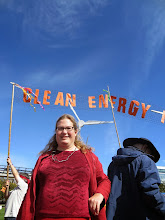A white paper co-authored by Westinghouse Solar and California Solar Energy Industry Association (CALSEIA) suggests that nationally, the new frontier for saving money on utilities is local generation solar.
Researchers used software from the U.S. department of energy to create and compare 30virtual homes in different parts of the United States, with a variety of home ages, climatic and economic factors.
The paper shows homes will see more savings with local power generation compared to further energy conservation measures.
Now, we at The Solar Gardens Institute say insulate and seal the structural envelope of your home, but then generate some electricity for yourself and a few friends!
The complete text of the paper is available at http://www.westinghousesolar.com.
Researchers evaluated three different ages of homes (old, typical and new) in 10 cities for a total of 30 different test simulations to determine what combination of energy efficiency and renewable generation makes the most sense for homeowners.
The conclusions are significant given that the residential sector consumes 22 percent of the energy in the United States, and there are only two ways to structurally reduce a home's energy costs: energy efficiency and energy generation.
Ok, that is great for people with optimal roofs for solar panels.
The rest of us can band together and create electricity that will not be subject to energy cost adjustments, swings in natural gas and coal markets, will not create air pollution with electricity and will build community through solar gardens.
"This study proves what common sense would tell us - it's simpler to put an energy source near to the load," said The Solar Gardens Institute Founder Joy Hughes. "With local energy generation and storage, we can efficiently use a smarter, smaller grid. Public and private investment should be steered towards distributed energy development."
See more about Solar Gardens at http://www.solargardens.org
Here are the by-project findings of the paper:
The results of these 30 different home simulations are that climate, local utility rates and home condition are the biggest factors in determining what are the most cost effective energy savings measures.
Lighting retrofits are always cost effective.
Weatherization and insulation energy efficiency measures are most cost effective in old homes in cold climates, but are not cost effective in newer homes or in temperate climates. Basic building shell and ventilation energy efficiency measures are most cost-effective in cold climates, but have long paybacks in more temperate zones.
Rooftop solar power systems have good paybacks regardless of home condition in sunny areas and in areas with either high electric rates or high solar incentives.
Solar thermal systems have good paybacks when the fuel source for hot water is electricity. Upgrades to Energy Star appliances and equipment are generally cost-effective when replacing broken or obsolete equipment, but are generally not cost effective when the existing equipment is still functional (analogous to not upgrading to a new, higher mileage car if the old one still works).
according to CALSEIA, most homes built since the mis 1980s have already gotten many efficiency upgrades or taken advantage of solar rebate, bonus and reward programs. Executive Director Sue Kateley called such improvements and payments "low-hanging fruit," and homeowners have harvested those savings.
Solar is usually assessed as the payback time or price per watt, have greatly improved.
"The economics for rooftop solar power systems have improved dramatically since 1980," said Barry Cinnamon, CEO of Westinghouse Solar. "According to these 30 home simulations, the most cost effective actions homeowners can take are to install energy efficient lighting and a rooftop solar energy system. We can't conserve our way to energy independence; but fortunately, with affordable rooftop solar we can now generate much of the energy we need."
The results outlined in the white paper are somewhat contrary to "conventional wisdom" regarding cost effectiveness for energy efficiency and solar energy systems.
Let's break with the "conventional wisdom" or power generation miles and limes away from the end users.
Subscribe to:
Post Comments (Atom)


No comments:
Post a Comment